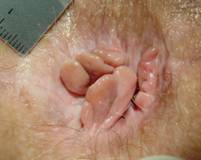As early as 2250 BC hemorrhoids have been recorded in literature to some extent. It would probably be safe to say that it is one of the oldest ailments known to people. The Egyptians were the first people who medically recorded the remedies for hemorrhoids. They used a poultice of dried acacia leaves with a linen bandage to heal protrusions and inflammations of venous material. A Greek physician named Hippocrates also wrote about hemorrhoids describing it as bile or phlegm which is determined to be the veins in the rectum. He treated the anal protusions very crudely avocating pulling the tissue off with the finger tips, or pulling the veins upward, while someone puts a hot iron to the hemorrhoid and burns it off. The first recorded endoscopy (use of speculum to inspect the rectum)can also be credited to Hippocrates. Even the bible has records of hemorrhoids in the earliest times from the Old Testament Book of Samuel 5:9 Philistines, “punished with emerods” and Samuel 5:12, “People who moved the Ark to Ekron were punished with emerods”.
One of the earliest known hemorrhoid treatments was with the aloe vera plant. Dioscorides, a Roman physician started using that to treat inflamed hemorrhoids. Then approximately 130-200 AD a Roman physician named Emperor Marcus Aurelius (Galen) prescribed ointment, laxatives, and leeches for hemorrhoids treatment. During the same time period in India, the use of clamp and cautery was used to get rid of hemorrhoids and control bleeding.
Between the 5th and 10th Century, Byzantine physicians used thread to ligate the base of the hemorrhoid and then followed by its amputation.
In 1935, Doctors E.T.C. Milligan and C. Naughton Morgan further studied the excision and ligation methods, which later became the gold standard in hemorrhoidectomy.
In the 1960s, banding of larger hemorrhoids was introduced with rubber band ligation.
In the 1970s, cryotheraphy, diathermy, and laser cauteries were developed for treatment.
In the 1990s, Stapled Hemorrhoidopexy, also known as Procedure for Prolapse & Hemorrhoids (PPH) was first described by an Italian surgeon – Dr. Antonio Longo, and since then has been widely adopted to treat the grade 3 and 4 hemorrhoids. Moreover, Another non surgical procedure, called Infra-red coagulation (IRC) was developed to treat the early stage of hemorrhoids.
 Anal skin tags often occur if an individual heals the thrombosed external hemorrhoids at home without surgery, the thrombosed hemorrhoids may leave behind skin tags. Anal sentinel tags may also form because of non-hemorrhoid causes, such as anal fissure, surgery, or infection, etc.
Anal skin tags often occur if an individual heals the thrombosed external hemorrhoids at home without surgery, the thrombosed hemorrhoids may leave behind skin tags. Anal sentinel tags may also form because of non-hemorrhoid causes, such as anal fissure, surgery, or infection, etc. 



